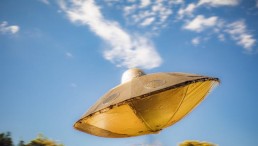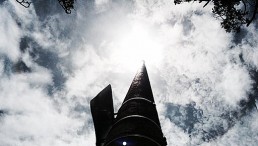Despite reports circling the Internet recently, NASA has not yet created a new fuel-free, faster than light propulsion system, the space agency said.
A team based at NASA's Johnson Space Center in Houston reportedly tested a prototype engine system in a vacuum recently and determined that it had a small amount of thrust. This news hit the Internet and was linked with the long sought after warp drive.
So why all the fuss? The thruster system is based on the EmDrive, a British invention said to create thrust without propellant by bouncing microwaves around inside a chamber. If it works, it could change spaceflight as we know it while also violating the laws of physics in the process.
However, NASA is downplaying the research and its potential to deliver a huge propulsion breakthrough in the future.
"While conceptual research into novel propulsion methods by a team at NASA's Johnson Space Center in Houston has created headlines, this is a small effort that has not yet shown any tangible results," NASA officials told Space.com in a statement. "NASA is not working on 'warp drive' technology."
"The reason it's controversial is, it violates Newton's Third Law," Brian Koberlein, an astrophysicist who studies general relativity and computational astrophysics.
It's possible that electromagnetic leaks in the chamber or coupling with Earth's magnetic field are responsible for the supposedly impossible result, said Koberlein, who is based at the Rochester Institute of Technology. But the recent test in the vacuum chamber, if it is indeed valid, does rule out another prosaic explanation - that the engine was pushing against Earth's atmosphere in some way, he added.
Ethan Siegel, a physics and astronomy professor at Lewis & Clark College in Portland, Oregon says he hopes the NASA Eagleworks team members continue their research into the drive's development.
"It's to make sure we give this the third-degree treatment and scrutinize it as much as we can," he said. "We do not want false hope for a miracle device that is never going to happen. Before we believe this, let's do all of the robust tests, look at all the criteria and make sure we're not fooling ourselves."
Part of NASA's mandate is to fund research that follows interesting leads, even if the research doesn't conclude with the production of a working prototype.
"This is part of what NASA does in exploring the unknown, and the agency is committed to and focused on the priorities and investments identified by the NASA Strategic Space Technology Investment Plan. Through these investments, NASA will develop the capabilities necessary to send humans further into space than ever before," they said.




![Sat-Nav in Space: Best Route Between Two Worlds Calculated Using 'Knot Theory' [Study]](https://1721181113.rsc.cdn77.org/data/thumbs/full/53194/89/56/50/40/sat-nav-in-space-best-route-between-two-worlds-calculated-using-knot-theory-study.png)









